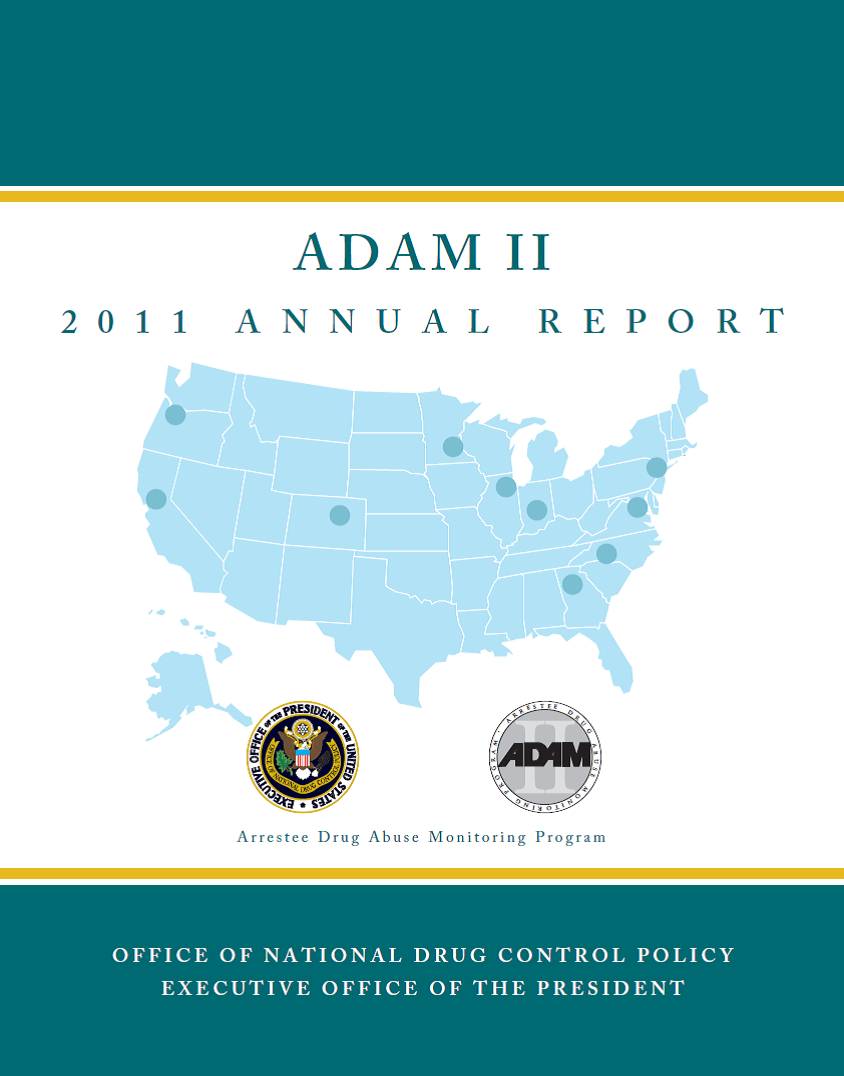The Arrestee Drug Abuse Monitoring (ADAM II) 2011 Annual Report Highlights
 The Arrestee Drug Abuse Monitoring (ADAM II) study is a Federal data collection program that conducts voluntary interviews and tests for drugs in adult male arrestees held in police booking facilities. Operating in nine U.S. counties and the District of Columbia, ADAM II collects data within 48 hours of arrest, providing a window into drug use behavior among booked male arrestees that is not available when persons are detained or incarcerated for longer periods of time.
The Arrestee Drug Abuse Monitoring (ADAM II) study is a Federal data collection program that conducts voluntary interviews and tests for drugs in adult male arrestees held in police booking facilities. Operating in nine U.S. counties and the District of Columbia, ADAM II collects data within 48 hours of arrest, providing a window into drug use behavior among booked male arrestees that is not available when persons are detained or incarcerated for longer periods of time.
The 2011 ADAM II Sites
- Atlanta, GA (Fulton County)
- Charlotte, NC (Mecklenburg County)
- Chicago, IL (Cook County)
- Denver, CO (Denver County)
- Indianapolis, IN (Marion County)
- Minneapolis, MN (Hennepin County)
- New York, NY (Borough of Manhattan)
- Portland, OR (Multnomah County)
- Sacramento, CA (Sacramento County)
- Washington, D.C. (District of Columbia)
Key Findings
- Drug use among the arrestee population is much higher than in the general U.S. population.
- At the 10 sites participating in the ADAM II study, over 60 percent of booked arrestees tested positive for at least one illicit drug at the time of their arrest.* In 5 of the sites (Chicago, Minneapolis, New York, Portland, and Sacramento), 70 percent or more tested positive.
- The proportion of arrestees in each site testing positive for any drug ranged from 64 percent (Atlanta) to 81 percent (Sacramento).
- Cocaine positives have declined significantly in all ADAM II sites since 2007 (see chart, page 2). In New York and Chicago, cocaine positives dropped from 50 percent or more in 2000 to half that in 2011.
-
The most commonly detected drug in all sites was marijuana (from 36 percent in Atlanta to 56 percent in
 Sacramento).
Sacramento). - Cocaine in powder or crack form was the second most commonly detected substance in 8 of the 10 sites in 2011. In 6 sites, 20 percent or more of arrestees tested positive for cocaine in 2011.
- The proportion of arrestees in each site who tested positive for multiple drugs in their system ranged from 13 percent (Charlotte) to 38 percent (Sacramento).
- The proportion of arrestees testing positive for opiates (heroin and prescription pain relievers) has increased significantly in 5 of 10 sites since 2000 and 2001, more than doubling since 2000 in Denver (to 10 percent) and more than tripling in Indianapolis (to 10 percent) in 2011.
-
Of those who admitted to drug use in the prior 12 months, less than 16 percent had been in any outpatient or inpatient treatment in the prior year.
- Only 2 percent (Atlanta) to 15 percent (Portland) reported receiving outpatient drug or alcohol treatment in the past year.
- 3 percent (Atlanta) to 16 percent (Portland) reported receiving inpatient or residential substance abuse treatment in the past year.
- 2 percent (Atlanta) to 4 percent (Portland) reported receiving inpatient mental health or psychiatric treatment.
- Methamphetamine rates remain highest in the two Western sites, with 43 percent (Sacramento County, CA) and 23 percent (Multnomah County, OR) of arrestees testing positive for the drug.
Background
ADAM II is a continuation of the ADAM program that operated in 35 sites from 2000 to 2003 under the auspices of the National Institute of Justice. Since 2007, ADAM II has been sponsored by the Office of National Drug Control Policy (ONDCP). The program will be continued through 2012, but with only 5 sites (New York, Chicago, Atlanta, Denver, and Sacramento).
Although not a national data set, ADAM II provides information on the local level that demonstrates regional variability in drug use patterns and which can be used by local authorities to inform decisions.
The ADAM II 2011 Annual Report is ONDCP’s fifth annual report for ADAM II, providing voluntary interview and urine test data collected from a probability-based sample in each of 10 sites, representing 35,459 adult male arrestees during the data collection period.
For an electronic copy of the ADAM II 2011 Annual Report, visit http://obamawhitehouse.archives.gov/ondcp/arrestee-drug-abuse-monitoring-program.
